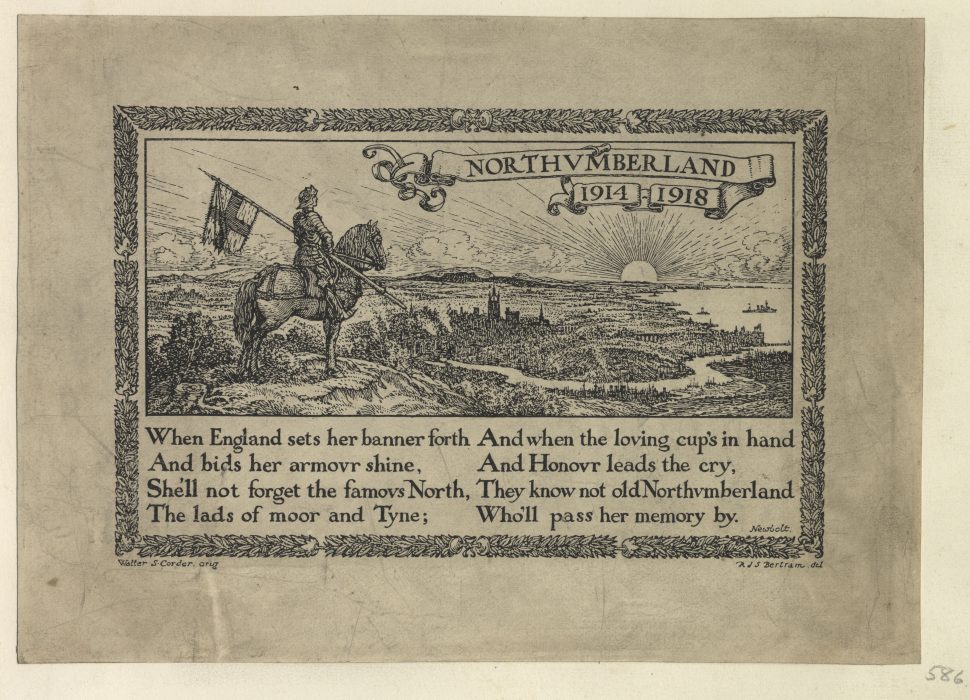Northumberland 1914-1918, Poem and Illustration
Reference: SANT/PHO/ALB/5/586
Suggested age groups: KS2, KS3, KS4, Lifelong Learners
Subject areas: History, Literacy, Art
CONTEXT
This is part of a longer poem by Sir Henry Newbold called “The Old and the Bold” about Admiral Lord Nelson and Vice Admiral Cuthbert Collingwood. Sir Henry published several series of poems about British naval heroes before the First World War. These patriotic poems were very popular during the war and a
collection of them (“Poems: New and Old”) was reprinted six times between 1914 and 1918.
During the war, Sir Henry worked for the War Propaganda Bureau. Although written before the war, his poem “Vitai Lampada” [Latin for “the torch of life”] was very popular. It draws a link between playing sport at school and military spirit (see link below).
His poem “The War Films” (see link below) is about the strangeness of seeing “living pictures of the dead”. By the time of the First World War, film had become a mass medium, with cinemas in most towns. Audiences were keen to see news and documentary films about the war, including the massively popular “The Battle of the Somme”.
ACTIVITIES
ACTIVITY 1
Background
This is part of a longer poem by Sir Henry Newbold called “The Old and the Bold” about Admiral Lord Nelson and Vice Admiral Cuthbert Collingwood. Sir Henry published several series of poems about British naval heroes before the First World War. These patriotic poems were very popular during the war and a collection of them (“Poems: New and Old”) was reprinted six times between 1914 and 1918.
SEE
See: Who wrote this poem?
See: What is the name of the longer poem that this is part of?
See: Who is this poem about?
See: How many times was the patriotic poem collection “Poems: New and Old” printed during WW1?
THINK
Think: Whose viewpoint is the poem told from?
Think: What influenced the poet to write this poem?
Think: What narrative is being told through the poem?
Think: What linguistic features are used to convey meaning in the poem?
Think: What is the form and structure of the poem?
Think: What is the purpose of the poem?
Think: How does the poem affect the reader?
DO
Do: Create a poster illustrating the narrative of the poem. Select key phrases or lines from the poem to include on the poster.
Do: Choose three words from the poem that sum it up. Use these three words to form the basis of your own poem.
Do: Write an alternative title for the poem. Does this change the meaning of the poem?
Do: Identify all of the nouns, verbs, adverbs and adjectives in the poem. Make a word cloud. Is there any sort of pattern? Try changing some of those words – what affect does it have on the mood of the poem?
Do: In a small group learn the words to the poem to perform to the rest of the class. Think about who says which line/word. Can you create emphasis by saying certain words together as a group? Will you say, whisper, shout or sing some words/lines?
Do: Close your eyes and listen to the poem being read out. Create an abstract continuous line drawing while listening to the poem responding to what you hear. Explain why you have drawn it that way.
Do: Write out the poem using the pattern of your abstract line
drawing. Add colour and illustrations where necessary. Explain why you have chosen to present the poem this way.
Do: Analyse the poem in depth. Consider the questions from the “Think” section and use them to help you annotate the poem.
Do: Write a statement about the poem discussing why the poet has chosen each feature to illustrate the meaning of the poem.
Resources
ACTIVITY 2
Background
Sir Henry published several series of poems about British naval heroes before the First World War. These patriotic poems were very popular during the war and a collection of them (“Poems: New and Old”) was reprinted six times between 1914 and 1918.
During the war, Sir Henry worked for the War Propaganda Bureau. Although written before the war, his poem “Vitai Lampada” [Latin for “the torch of life”] was very popular. It draws a link between playing sport at school and military spirit (see link below).
SEE
See: Where did Sir Henry work during the war?
See: What is Sir Henry’s poem “Vitai Lampada” about?
See: What is Sir Henry’s poem “The War Films” about?
THINK
Think: What is patriotism?
Think: Why would patriotic poetry be popular during the war?
Think: What is propaganda?
Think: How was poetry used as propaganda?
Think: How could this poem have been used as propaganda?
Think: Was patriotism used as propaganda during WW1?
DO
Do: Research the War Propaganda Bureau. Are there any famous authors that you can find who worked there?
Do: Write a propaganda poem to promote the war.
Do: Write a patriotic poem celebrating where you come from.
Do: Illustrate your poems in the same way that this poem has been illustrated to be printed in a newspaper.
Resources
OTHER ONLINE RESOURCES
Sir Henry Newbold and His Poetry
Melodic Verses website, page for “The Old and the Bold” (full text): https://melodicverses.com/poems/37486/The-Old-And-Bold
Poetry Foundation website, page about Henry Newbolt: https://www.poetryfoundation.org/poets/henry-newbolt
Poetry Foundation website, page with text of “The War Films” poem: https://www.poetryfoundation.org/poems/57319/the-war-films
Firstworldwar.com website, page about Sir Henry Newbolt, including text of “Vitai Lampada”: https://www.firstworldwar.com/poetsandprose/newbolt.htm
British Library website, page about “Poems: Old and New”: https://www.bl.uk/collection-items/poems-new-and-old
War Propaganda Bureau
Spartacus Educational website, page about the War Propaganda Bureau: https://spartacus-educational.com/FWWwpb.htm
The Battle of the Somme (Film)
Imperial War Museum website, page about the filming of “The Battle of the Somme”: https://www.iwm.org.uk/history/how-the-battle-of-the-somme-was-filmed
YouTube website (posted by The National Archives), “Battle of the Somme” film extract (4 minutes): https://www.youtube.com/watch?v=3lTnK5LAoBc
YouTube website, “Battle of the Somme” full film (1 hour 15 minutes): https://www.youtube.com/watch?v=xQ_OZfaiUlc


